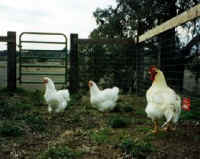Animal Welfare and Labeling
 Professor Chen’s interesting and provocative posting, The Carnivore’s Dilemna deserves some additional comment. In this post, Professor Chen considered meat product labeling that provides consumers information about the methods by which the animals were raised, such as the new “animal compassionate” label. While one might quibble with the term compassionate, I suggest that these types of labels have arisen as a result of two trends moving rapidly in opposite directions.
Professor Chen’s interesting and provocative posting, The Carnivore’s Dilemna deserves some additional comment. In this post, Professor Chen considered meat product labeling that provides consumers information about the methods by which the animals were raised, such as the new “animal compassionate” label. While one might quibble with the term compassionate, I suggest that these types of labels have arisen as a result of two trends moving rapidly in opposite directions. On one hand, in recent years, animal husbandry practices in agriculture have followed a model that is increasingly cruel to the animals produced. The cost efficiencies promised by intensive animal production (disputed by Michael Pollan in Modern Meat and by Eric Schlosser in his recent article, Cheap Food Nation) have been used to move animal agriculture to an industrialized model that now produces most of the meat found in our grocery stores. Animals are produced with means similar to the industrialized production of non-living products with the driving emphasis being more product, faster and at less direct cost. Any person who has ever walked among chickens in a backyard flock and then entered a modern chicken house with 40,000 birds, each allotted .68 square feet or less of space understands the animal welfare problems. But, these are not the concern of the industrialized model.
On one hand, in recent years, animal husbandry practices in agriculture have followed a model that is increasingly cruel to the animals produced. The cost efficiencies promised by intensive animal production (disputed by Michael Pollan in Modern Meat and by Eric Schlosser in his recent article, Cheap Food Nation) have been used to move animal agriculture to an industrialized model that now produces most of the meat found in our grocery stores. Animals are produced with means similar to the industrialized production of non-living products with the driving emphasis being more product, faster and at less direct cost. Any person who has ever walked among chickens in a backyard flock and then entered a modern chicken house with 40,000 birds, each allotted .68 square feet or less of space understands the animal welfare problems. But, these are not the concern of the industrialized model. On the other hand, as agriculture has gone in one direction, public concern about animal welfare has gone in the opposite direction. Americans express increasing concern about the well-being of animals. Readily apparent examples abound. We spend more on our pets, we enact stronger anti-cruelty statutes for animal abuse, and we even dare to regulate farming practices through referendum. Our concerns are fueled by scientific studies that show that animals have far greater intelligence, and more capacity to suffer than has ever before been realized.
On the other hand, as agriculture has gone in one direction, public concern about animal welfare has gone in the opposite direction. Americans express increasing concern about the well-being of animals. Readily apparent examples abound. We spend more on our pets, we enact stronger anti-cruelty statutes for animal abuse, and we even dare to regulate farming practices through referendum. Our concerns are fueled by scientific studies that show that animals have far greater intelligence, and more capacity to suffer than has ever before been realized. In light of these conflicting trends, I suggest that the new labeling is not a plot hatched by farmers, but the natural result of consumer concerns about the direction that agriculture has taken. American farmers as well as policy-makers who have become accustomed to consumers who did not meddle in farm or food policy may well be caught off guard. As Professors Jeff Leslie and Cass R. Sunstein write in their article Animal Rights without Controversy, and discuss in the University of Chicago Law School blog, the labeling of meat products is an opportunity to “bring our practices and our moral judgments into closer alignment.” They argue that “consumers should be informed of the treatment of animals used for food, so that they can make knowledgeable choices about what food to buy.”
In light of these conflicting trends, I suggest that the new labeling is not a plot hatched by farmers, but the natural result of consumer concerns about the direction that agriculture has taken. American farmers as well as policy-makers who have become accustomed to consumers who did not meddle in farm or food policy may well be caught off guard. As Professors Jeff Leslie and Cass R. Sunstein write in their article Animal Rights without Controversy, and discuss in the University of Chicago Law School blog, the labeling of meat products is an opportunity to “bring our practices and our moral judgments into closer alignment.” They argue that “consumers should be informed of the treatment of animals used for food, so that they can make knowledgeable choices about what food to buy.”I, for one, see this as an exciting development for agriculture. It provides us with an opportunity to evaluate our food system openly and for the consumer of food to once again connect to the producer of food. Surely, together we can do better than we can do apart.










0 Comments:
Post a Comment
<< Home